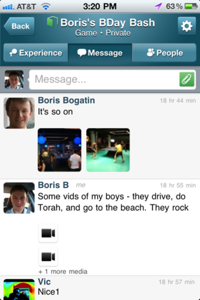This morning, another new startup launched a mobile social networking application where location is the primary feature and friends comes second. Banjo, which shows you all the people nearby upon first launch, is one of many similar services now arriving to fill a void in the social networking space. These services are identifying the disposable, the elastic and the ephemeral social networking that occurs – or could occur, given the right technology – when tied to a particular location at a particular point in time.

But does Banjo have the winning formula? What about the others? And will anyone really use these services?
Banjo vs. Sonar: Are These Clones or Different Ideas?
Banjo is most similar to another app called Sonar, which launched in May at the TechCrunch Disrupt conference. Like Banjo, Sonar only uses publicly available information to locate people nearby. It also doesn’t require to you to connect to your social networks, like Facebook and Twitter. But if you choose not to, you miss out on the app’s key feature: the way it identifies your friends and your friends of friends that are nearby.

When at a venue, Sonar ranks the people there by how many friends you have in common. This is most helpful, obviously, to those who already participate on Facebook and Twitter, but it’s also a big difference from how Banjo works. On Banjo, it’s less about how you’re connected to others, and more about just who’s there right now. Sonar is also restricted to nearby users, while Banjo lets you expand your radius or even look up far away locations.
In addition, Sonar only gathers location data from Foursquare currently. In the future, the company plans to add both explicit check-in services, like Facebook Places and Gowalla, and services where the check-in is implied, like Meetup and Eventbrite. However, it’s stopping short of mining other social networks for the geotagged posts and media, which Banjo uses.
Finally, there are some slight technical differences, too: Sonar requires users run the latest version of the iPhone operating system, iOS 4.2, while Banjo works on older versions of the software, starting at iOS version 4.0 and up. Banjo currently has an Android app, but Sonar’s is in the works.
Lokast: These Apps are Just Features of Our App

Sonar is hardly the only app playing in this space these days. It’s just the most similar to the latest entry, Banjo. Other newcomers include the photo-sharing startup Color and the like (see: Trover, Tracks), which focus on photos as the jumping off point for location-based networking.
Meanwhile, location-based startup Lokast sees all its competitors, from local public chatting app Yobongo to group texting apps like Beluga and Groupme, as startups building entire companies on top of one of its feature sets, either current or on its roadmap.
Lokast is still struggling a bit with design (the new, but still unpublished design, not shown here, is better). It has some of the most interesting technology under the hood. Although it doesn’t yet use the publicly available geodata like Banjo and some others do, the upcoming Android version promises something unique: Qualcomm’s AllJoyn, a peer-to-peer technology that works over Wi-Fi, or given OEM integration, Wi-Fi and Bluetooth. Still somewhat experimental, this technology provides a way for the app to use the built-in radios on the phone to connect to whoever’s nearby, and form ad hoc networks, as well as share data. With AllJoyn, the connection is more accurate and faster than a similar connection made using GPS and 3G.
In addition, when Wi-Fi direct becomes more prevalent, Lokast found its ability to pinpoint people’s locations using this technology increased by 900% during simulations. The eventual goal is to increase location accuracy down to three to five feet, the company says. This is only two to three years away, given ubiquitous device-to-device technology, says Lokast’s CEO Boris Bogatin. In the meantime, Bogatin predicts that the company will be at sub-10 meters within a year or so, on a fairly consistent basis, most likely on Android first.
Lokast has two patents pending, one for its content distribution technology and another, a location ID system, whose technology the company believes it’s already seeing in some of its competition’s software. To determine a physical location, the system uses a wide range of both relative (person is X# of feet away) and absolute (person is standing in corner at this exact spot) location techniques. Instead of using signals like sound (see: Shopkick) or light (see: Color), it uses wireless RF to determine location, which is more accurate.
In terms of functionality, Lokast offers “disposable” social networks tied to a location. You can chat with a public location-based group, similar to Yobongo, and share media, or you can start private groups where you text, share photos, videos, links and more. Once you’re in that private group, the group becomes elastic, like Beluga and GroupMe offer – you can communicate with members even after you’ve left the location. And a friending feature allows for private, one-on-one communications, also unbound from the location where you first met.
Will Mainstream Users Come?
But winning the mindshare of the mainstream takes more than technology, it takes design, marketing and a certain viral effect. Group texting and chat apps were the hit at SXSW in Austin this year, where a great crowd of people spread out all over town, heading to different events and parties and needing a way to keep up with friends. But outside of that more unique use case, where do these startups fit in with users’ daily lives? Anecdotally, we’ve seen usage of these apps taper off dramatically in the months that followed.
Which startup has the ability to push forward to become a new social behavior? It’s probably too soon to say. But for anyone looking for the “post-Facebook” social networks, they’re already here.










